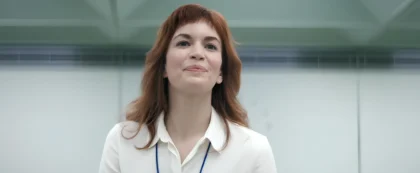The newcomer who challenges the system
Helly in Severance is introduced in the very first minutes of the show. But just like the viewer, she also wakes up with no context. Her inner consciousness—the so-called “innie”—comes to life in Lumon’s conference room with no memories, no identity, and no explanation. From that moment on, she emerges as a character who refuses to accept the imposed reality.
While the other employees are already resigned to the company’s routine, Helly in Severance acts as a disruptive force. From the early episodes, her instinct is to resist. She questions orders, challenges commands, and rejects both the emotional and symbolic control imposed by the corporation. Her unrest sparks a chain of events that shake Lumon’s structure—and inevitably, those around her.
Her relationship with Mark, which should have been a smooth onboarding into the new environment, quickly becomes a constant clash. Dylan watches her with irony. Irving grows silently uncomfortable. Even Milchick, always eager to maintain the company’s friendly tone, is forced to recalibrate his approach. Helly doesn’t join to adapt. She joins to interrupt.
In interviews, Britt Lower shared that “Helly turned Mark’s world upside down,” revealing how the character disrupts the apathy around her and reshapes the dynamics of that space.
Britt Lower’s visceral performance
To play Helly, Britt Lower had to start from zero in Severance—literally. In interviews, she said portraying a character with no past or identity was one of the greatest challenges of her career. She compared the experience to “acting without ground beneath her feet,” building a personality from total absence.
Lower also emphasized how the filming environment directly shaped her emotional performance. The symmetrical hallways, cold lighting, and silent spaces of Lumon amplified the sense of claustrophobia and tension. According to her, the discomfort was real—it even influenced how she breathed during scenes.
Still, the process wasn’t isolating. The actress praised director Ben Stiller and the team for creating a collaborative space that allowed her to explore Helly’s discomfort, rebellion, and anger without restraint. As a result, she brought to life a complex Helly—tense, provocative, but also deeply human.
Helly as a symbol of collective resistance
More than a striking character, Helly in Severance represents something bigger: refusal. She reflects the discomfort so many feel in dehumanizing environments—especially in corporate worlds that seek to erase individual identity.
In the show’s narrative structure, Helly embodies the archetype of the instinctive rebel. Someone who, even without knowing what lies beyond, intuitively feels that the present reality must be challenged. Her initial resistance doesn’t come from logic, but from a visceral response to oppression. In doing so, she exposes not just her own strength but also the system’s fragility.
With each act of defiance, Helly forces others to face what they’d rather ignore.
And that’s exactly why she becomes so central to the show’s experience.
Helly says no — but what lies behind the system she’s resisting? Discover Lumon’s secrets and the foundations of the Severance world in our full explanation.
Access the complete Severance guide
Final thoughts
Helly is the first to say no—and perhaps the only one to do so that early.
Her discomfort is immediate, her reaction nonnegotiable. It doesn’t matter how hard Lumon tries to soften the boundaries of obedience—she senses them, and refuses.
By refusing to forget who she is, even without knowing, Helly in Severance becomes more than a character. She becomes an unsettling question at the heart of a system that only functions as long as no one asks it.
Not all resistance is instinctive. Not all obedience is safe.
Dive into the journey of Helena Eagan, the most ambiguous piece in Lumon’s game.
Explore more from Severance!
Mark Scout in Severance: Who Is the Protagonist Played by Adam Scott?
Cold Harbor in Severance: Mind Fragmentation and the Limits of Corporate Pain
Lumon in Severance: the company that turned obedience into a cult
Severance and the Illusion of Compartmentalized Suffering: What the Body Reveals About Hidden Trauma
Lumon in Severance: the company that turned obedience into a cult
Posts Recomendados
Carregando recomendações...



